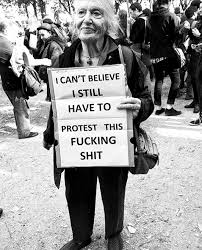Though the pay gap is certainly nothing to celebrate, how will you mark the day? What changes will you demand to build momentum for change?
The reason I ask is that I fear equal pay is seen by some as a quaint holdover of 1970’s feminism (surely we’ve sorted that one by now). It’s the equivalent of bra burning. Who needs that when a GIF will do. Yeah technology! Thank you for saving feminists from high lingerie bills.
Or perhaps, and I don’t blame you the slightest if you feel this way, some of us are suffering from equal pay fatigue. Have you pictured yourself grey haired at a protest in, say fifty-years, with one of those signs reading, “I can’t believe I still have to protest this f***ing sh**?”. I know I have.
Yes, there’s a lot for a busy feminist to turn her (or his) attention to these days, and the enormity of fighting on many fronts can take a toll. But we mustn’t let this slide down the agenda or give in to the fatigue. The pay gap remains a stubborn old thorn in our collective feminist sides– and by the looks of it is here to stay.
Two weeks ago, the Workplace Gender Equality Agency reported that the gender pay gap is ever so slightly down this year by .9%. It now sits at 15.3%. A full time working man is $251.20 better off per week than a woman. Earlier this year, the WGEA suggested that at the current rate of change, it would take 50 years of more to sort it.
That is, unless we get our skates on and make a whole lot of noise. What better time to kick up a fuss than on Equal Pay Day? And let’s not leave it there – let’s keep up the pressure all year – or, if necessary, for years — until we get this sorted.
Momentum is building. You won’t be the only one at the equal pay party. I may be guilty of incredibly misguided glass half full feminist thinking, but I really believe this.
Last week, opposition Leader Bill Shorten addressed the issue on ABC’s Q&A, promising Labour would help tackle the pay gap by supporting test cases in child care and aged care, both female dominated industries where women have traditionally been underpaid.
Earlier in the month, Shadow Treasurer Chris Bowen told the Women’s Economic Network that the pay gap had been “in neutral for 20 years” and he put forward a case for tackling it.
(Could these two recent interventions from Labour be early indications they plan to make equal pay a big issue ahead of the next election – a prominent part of their ongoing social equality pitch to voters? Oh, I do hope so.)
Also last week, 122 business leaders, part of Male Champions of Change, publicly committed to close the gender pay gap in like-for-like roles within their organisations. Though I have recently asked what took them so bloody long if this most basic equal pay principle (paying Paul and Sally the same wage for doing the same job) has been in place since 1969, the point is they are here now. Maybe they got their bell bottoms tangled and tripped on their way to the equal pay party sometime in the 1970’s.
So here are a few thoughts on how we can make some noise about equal pay:
If like a kid before Christmas you find it hard to wait for Equal Pay Day, or you just prefer to ‘celebrate’ the pay gap every day, earlier this month Hannah and Eliza Reilly of the ABC program Growing Up Gracefully came up with an ingenious option.
They figured that if you subtract the gender pay gap from an 8-hour-work day, women in Australia are only paid until 3:45pm. The accompanying tongue in cheek musical video and #LeaveAt343 were widely shared.
Yes, in light of the updated pay gap figures subsequently released by the WGEA , Hannah and Eliza will now have to recalculate their timings. But this is a great idea. (Can I digress for a moment to applaud these two ladies for literally making a song and dance of the pay gap).
But if singing and dancing aren’t your bag or you don’t fancy a daily mid-afternoon tools down moment, the WGEA has offered up a “support pay equity” social media pack, which encourages us all to share a meme pointing out that only 27% of employers analyse their pay roll for pay gaps. Yes, only 27%. That’s appalling.
In light of so few employers voluntarily taking action to measure their pay gap (and presumably doing something about it), and despite the Male Champions of Change call to other CEO’s to join them in doing so, might I suggest we call for mandatory equal pay reporting. Fed up with the lack of progress with voluntary reporting in the UK, a Conservative government (yes, a Conservative government) introduced mandatory reporting this year, with potentially revolutionary implications.
I know it’s a terribly unsexy battle cry: “What do we want? Mandatory equal pay reporting. When do we want it? Now!” It also doesn’t fit on a button or bumper sticker, or lend itself to a GIF or meme, but let’s go with it.
And while we’re on the subject of pay transparency, why not get rid of ‘pay gag clauses’ so employees can freely talk about their salaries without fear of punishment. Last year, Greens Senator Larissa Waters introduced a private members bill to do just that, claiming employers were using the practice to mask unfair pay decisions and punishing women who ask for pay equity.
I would also suggest you lend your support to United Voice Union, who are bringing a potentially precedent setting case to the Fair Work Commission on behalf of underpaid child care workers. They want to demonstrate that early childhood educators are underpaid compared to male dominated professions with similar qualifications.
This case will get to the very heart of the “undervaluing of women’s work”, which in plain English means that industries dominated by women are paid less than those dominated by men.
According to the Diversity Council research published last year, this undervaluing is driven by industry and occupational segregation, which account for 30 percent of the remaining pay gap. A win here could have far reaching implications and shift the goal posts.
(Another digression. Bless the early childhood educators. Here they are employing an even older school, downright Suffragette tactic to draw attention to their cause: chaining themselves to the Prime Minister’s Office.)
We can add to the list all sorts of changes to tackle occupational segregation, lack of flexible work, the uneven distribution of unpaid care between men and women. Or as Kate Ashmor recently suggested in a column for Women’s Agenda, a Productivity Commission inquiry into women in the workforce would be a credible vehicle for examining all of these issues that have traditionally been put in the ‘too hard’ basket. We’re only just getting started.
So this Equal Pay Day, let’s make equal pay trendy – and trending. Whether you sing and dance, chain yourself to something or lend your voice to my admittedly awkward chant, please make some noise. Change is within our grasp. Fifty years is just too long to wait.



